 Sensors Series - Part 3 - Industrial Sensors
Sensors Series - Part 3 - Industrial Sensors
Long before innovations in semiconductor processing made the production of integrated circuit (IC) sensors and MEM sensors possible, industrial sensors were used to sense, detect and measure changes in the position, displacement, temperature, pressure, electrical current, and many other parameters of manufacturing processes and industrial equipment. But unlike the tiny form factor sensors used today on PCBs in smart phones or Internet of Things (IoT) devices, industrial sensors come in a much wider variety of sizes, shapes and technologies. Some are PCB-mounted ICs, while others are system level components integrated into a piece of machinery or an entire manufacturing production line. A familiarity of industrial sensors is useful to any engineer, whether he or she is just beginning their career, or are further along and desire to broaden their body of knowledge.
Related Components | Test Your Knowledge 
Applications Notes: Heavy Duty Pressure Sensors
sponsored by
2. Objectives
The objective of this learning module is to provide the trainee with basic knowledge of industrial sensors used in manufacturing processes and industrial control systems. You will first review some of the main concepts of sensor technology and then you'll gain some familiarity of sensors utilized in industrial automation and control systems.
Upon completion of this learning module, you will be able to:
- Describe the essentials of sensor technology
- Discuss how sensors are utilized in industrial automation
- List the types of industrial sensors used in manufacturing processes
- Explain the operation of the most common industrial sensors
3. Review
The essentials of IC sensors were covered in the Sensors I learning module, and included definitions, categories, classifications and characteristics. In the Sensors II learning module, we built on the sensors essentials covered in the first learning module and applied them to the Internet of Things (IoT) by focusing on sensors used in wearable devices, including medical wearable devices, smartphones and fitness wrist and arms bands.
Since IoT wearable devices are often used to measure the body's vital signs, Sensors II also discussed how the condition of the human body can be sensed using the skin, body fluids and movement as sensing mediums. In addition, optical sensors, employing photoplethysmographic technology, were discussed as a unique category of IoT sensors, and included how they are used to design a pulse oximeter to sense heart rates.
Finally, Sensors II covered the most common types of wearable sensors, featuring the following characteristics: low-power, lightweight, compact form factor, and multi-functional. These sensors include proximity, UV, heart rate, ambient light & temperature, and capacitive touch sensing. (For a more comprehensive review, please visit the previous learning modules.)
4. Introduction to Industrial Sensing
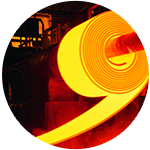
Those who are unfamiliar with the world of industrial electronics may be surprised to learn that the theory of industrial sensors is essentially identical to that of consumer applications of sensing. After all, sensing temperature as a thermodynamic measurement of the average kinetic energy of the particles in a system is the same whether the system is industrial or not. What is unique about industrial sensors is the applications and environments they are used in. For instance, as the image on the left of a hot rolled steel coil processing mill so aptly illustrates, industrial sensors must be able to withstand extreme conditions that non-industrial sensors would be unable to survive. (Note: Hot rolling is a milling process which requires rolling steel very high temperatures, typically over 1700 °F, which is higher than steel's recrystallization temperature.) In this section, we will cover some of the common industrial applications that utilize different types of industrial sensors. In this way, you will obtain some context of how these sensors are used. |
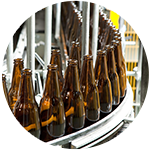
Photoelectric sensors (emitter/receiver pairs and reflectors) have been a mainstay of light sensing technology in manufacturing process control for decades. But, advances in image sensing and machine vision, especially for use in assembly robots, has catalyzed the application of optical sensors for industrial applications. Machine vision can be used to quickly inspect beer bottles for re-use. As glass bottles are moved by a conveyor, cameras that are strategically positioned can sense all surfaces of an empty bottle, looking for defects, chips, abraded areas, and contaminants. |
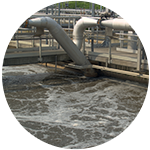
Liquid level sensors are utilized in many types of industrial applications that require monitoring fluid levels in a tank. Wastewater level monitoring in sewage treatment plants is an important control parameter for sedimentation basins, settling tanks, aeration basins and clarifiers. In addition, Level sensors are also used in sewage treatment plants to measure the hydrostatic pressure of sewage and effluent waste. |
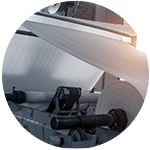
The paper converting industry (using converting machines as the one pictured on the left) converts raw paper manufactured at paper mills to paper end-products for paper materials such as bathroom tissue, books and other products. The process starts with wood fibers or pulp that's processed into a big continuous roll of paper called a web, which is then converted into small rolls by a slitter or rewinding machine. Rewinders are complex electro-mechanical machines with tensioning controls, motors and controllers. These devices use a variety of industrial sensors such as tension sensors, or absolute encoders to obtain position information, to ensure a quality converting process. |
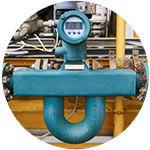
The distribution and transport of petroleum products, compressed air and other industrial gases require a means to monitor the effectiveness and efficiency of the transport system. Measurement of the flow of a fluid is critical to the oil and gas production process. Flow sensing can provide information to alert operators in piping failures such as perforations, ruptures, bursts, etc. |
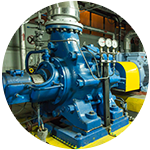
Pumping is a common industrial application in a wide variety of industries. Often pumps are driven by electric motors. Since pump failures, such as a frozen line, stuck impellor and bad bearings, can impact the operation of its electric motor drive, motors will commonly be protected by overloads sensors, current sensors, over temperature sensors/switches. |
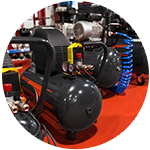
Industrial air compressors provide pressurized air to a variety of machines and other tools. They are often used in manufacturing, construction, chemical production, pneumatic power tools, oil and gas, food and beverage, and medical equipment applications. At its most basic level, an air compressor processes air from the outside to supply an air tank. Once the compressed air reaches a certain pressure point, the air compressor turns itself off. Air compressors utilize temperature, humidity and pressure sensors to not only maintain the compressor and its prime mover in safe operating conditions, but also to ensure the compressed air is dry when required by the application. |
5. Types of Industrial Sensors
There are many types of sensors used in industrial applications. In this section, we will get familiar with 21 common industrial sensors. While element14 has many different suppliers of industrial sensors, this learning module focuses on those manufactured by Honeywell, which typify the range of industrial sensors found in manufacturing process equipment today.
| - 5.1 Linear Position Sensors | ||||

SPS Series Linear Position SensorLinear position sensors have a variety of industrial applications, and are commonly used in valve positioning for bottling machines, food/chemical processing machinery, and water handling equipment, as well as CNC machines for monitoring tool depth and direction of travel. The SPS Series are magnetoresistive absolute position sensors, featuring a two-piece, non-contact design that's easy to integrate in an application or operate in a severe environment. They use a combination of an ASIC (Application-Specific Integrated Circuit) and an array of MR (magnetoresistive) sensors to determine the position of a magnet attached to a moving object so that the object's position can be determined. The MR array measures the output of the MR sensors mounted along the magnet's direction of travel. The output and the MR sensor sequence determine the nearest pair of MR sensors to the center of the magnet location. The output of these two MR sensors is then used to determine the position of the magnet between them. |
||||
| - 5.2 Mass Air Flow Sensors | ||||
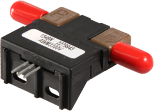
AWM3000 Series Mass Air Flow SensorWhile the most familiar application of mass air flow sensors (MAFs) are under the hood of your car, MAFs have a wide variety of industrial uses such as damper control for heating, ventilation and air conditioning systems, gas analyzers, low vacuum control, process control, leak detection equipment, fuel cells, and variable air volume control for HVAC systems. These sensors sense the amount of air flow and generate a voltage proportional to it. The AWM3000 Series are microbridge mass air flow/amplified sensors. The microbridge structure provides a sensitive and fast response to the flow and direction of air or other gas over the chip and provides a proportional output voltage. With a supply voltage from 8VDC to 15VDC, they will generate an output voltage at trim point of 5.0VDC at 1000 standard cubic centimeter per minute (sccm) with a response time of 3msec. The amplified version can be used to increase the gain and introduce voltage offsets to the sensor output. 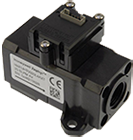
Zephyr HAF Series Mass Air Flow SensorThe Zephyr |
||||
| - 5.3 Hall Effect Sensors | ||||
The Hall effect has been known for over one hundred years, but did not become a basis for sensing technology until the mass production of semiconductors well into the mid 20th century became a reality. In its essence, the Hall element is constructed from a thin sheet of conductive material with output connections perpendicular to the direction of current flow. When subjected to a magnetic field, it responds with an output voltage proportional to the magnetic field strength. When the Hall element is combined with supporting electronics, it forms a Hall effect sensor. Hall effect sensors are seen in a wide variety of power supply, power generation and power converter equipment such as variable speed drives, overcurrent protection, ground fault detectors, current feedback control systems, robotics, UPS and telecommunication power supplies, welding power supplies, battery management systems. The CSDA Series is a Hall Effect Digital/Inductive Current Sensor that provides a logic level output that changes from approximately Vcc to 0.4V when the sensed current exceeds the operate point. It can operate on ac or dc current, but the output will turn off at every zero crossing when sensing AC current. The CSLA Series is a Hall Effect, linear current sensor. The sensing element is assembled in a printed circuit board mountable housing. The combination of the sensor, flux collector and housing comprises the assembly. |
||||
| - 5.4 Pressure Sensors | ||||
Pressure sensors are used in countless types of equipment, including but not limited to oxygen and nitrogen gas tanks, HVAC equipment, process controls, compressors, pumps, and robotics. While they come in a variety of sizes, types and specifications, some equipment require compact-sized, lightweight, pressure sensors. The 26PC Series are pressure sensors consisting of four piezoresistors on a chemically etched silicon diaphragm. A pressure change will cause a strain in the diaphragm and the buried resistors. The resistor values will change in proportion to the stress applied, which produces an electrical output. When pressure is applied, the resistance changes and the sensor provides a millivolt output signal that is proportional to the input pressure. The low power, non-amplified, non-compensated Wheatstone bridge circuit design provides inherently stable mV outputs over 1.0 to 250psi sensing ranges. The 26PC Series can measure both differential and gauge pressure as illustrated on the associated images. |
||||
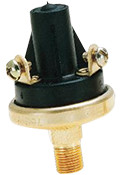
5000 Series Extended Duty Pressure SwitchIn some applications, pressure sensors combine the pressure sensing function with a switch to provide a contact closure for a control system. The 5000 Series is an example of this type of pressure sensor plus contact. It's an extended duty, high pressure switch with an integral electromechanical gauge pressure on/off switch with either single pole single throw (SPST) normally open or normally closed circuitry, or single pole double throw (SPDT) circuitry. It features a Kapton diaphragm for compatibility with a wide variety of fluids, and various terminations including a Metri-Pack connector that forms a tight seal when connected. Its high proof pressure and burst pressure ratings allow for use in many rugged applications that require the making or breaking of an electrical connection in response to a pressure change of the system media. The media (gas or liquid) pressure is applied via the port of the switch to a diaphragm or sealed piston. A precompressed spring on the other side of the sealed piston or diaphragm controls the set-point pressure. If the force resulting from the pressure is greater than the load on the spring, the electrical contacts within the switch will change state. If the contacts are normally open when no pressure is applied, they close on increasing pressure when the set point is reached. On decreasing pressure, the contacts will open again at a pressure somewhat less than the set switching point. The difference between the activation point on increasing pressure and the deactivation point on decreasing pressure is called hysteresis. The set point pressure for the switch can be configured such that the switch will actuate on increasing or decreasing system pressure. They are frequently used in engine transmissions, hydraulics and brakes, fuel pressure, generators, compressors and many more. |
||||
| - 5.5 Speed and Direction Sensors | ||||
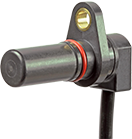
SNG-Q Series Quadrature Speed and Direction SensorMotors control systems use speed and direction sensing information for the proper operation of their control loops. They are commonly used are with AC induction motors, hydraulic pump motors, escalators and elevators for power and speed control. The SNG-Q Series Quadrature Speed and Direction Sensors are designed to provide both speed and direction information. Speed information is provided from digital square wave outputs; direction is provided using a quadrature output with signals 90° phase shifted from each other. With the quadrature output, target direction is determined by output lead/lag phase shifting. The series uses dual differential Hall-effect sensor IC technology to ensure accuracy. |
||||

Hazardous Location Industrial VRS Magnetic Speed SensorHazardous Location Variable Reluctance Speed (VRS) Magnetic Speed sensors are used in locations where explosion-proof or intrinsically safe sensors are required such as in oil and gas drilling equipment and machinery. They operate by means of a permanent magnet in the sensor that establishes a fixed magnetic field. The approach and passing of a ferrous metal target near the sensor's pole piece (sensing area) changes the flux of the magnetic field, and dynamically changes its strength. This change in magnetic field strength induces a current into a coil winding which is attached to the output terminals. The output signal of a VRS sensor is an AC voltage that varies in amplitude and wave frequency as the speed of the monitored device changes, and is usually expressed in peak to peak voltage (Vp-p). One complete waveform (cycle) occurs as each target passes the sensor's pole piece. If a standard gear were used as a target, this output signal would resemble a sine wave when viewed on an oscilloscope. VRS sensors are used as engine RPM (revolutions per minute) sensors on aircraft, automobiles, boats, buses, trucks and rail vehicles or motor drive RPM sensors on drills, grinders, lathes and automatic screw machines. They also are used in speed sensing of electrical generating equipment in grain elevators, saw mills and other potentially explosive environments. |
||||
| - 5.6 Relative Humidity and Temperature Sensors | ||||

HumidIcon
|
||||
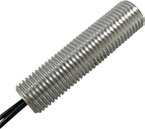
TD Series RTD Temperature SensorResistance Temperature Detectors (RTDs) are temperature sensors that contain an element that changes resistance value as its temperature changes. Most RTD elements consist of a length of fine coiled wire wrapped around a ceramic or glass core. The material has a predictable change in resistance as the temperature changes; it is this predictable change that allows it to be used to determine temperature. The TD Series are RTD (resistance temperature detector) sensors, and provide 8 Ohm/°C sensitivity, with near linear outputs. It has a 2000-ohm silicon resistive element that's packaged in a threaded aluminum case. It's suitable for air or liquid temperature sensing. Potential applications include motor overload and semiconductor protection, electronic assembly thermal management and temperature compensation, as well as HVAC/R equipment. |
||||

2455R Series Phenolic Automatic Reset ThermostatsCommercial thermostats include products for use in a wide array of small and major appliances, automotive applications, heat and smoke detectors and HVAC equipment. These snap-action thermostats include automatic or manual reset options, phenolic or ceramic housings, and a variety of mounting brackets and terminal options. The 2455R Series are single pole, single throw, snap acting nonadjustable thermostats. They are mainly used in applications such as power supplies, general appliances and features temperature sensitive bimetal disc which is electrically and thermally isolated from the switch to actuate the normally closed contacts. Contacts open when surface or ambient temperatures increase to the operating set point of the calibrated bimetal disc. The entire switch is enclosed in a phenolic housing. The bimetal disc is retained by a metal heat conducting end cap. Due to the small size of this unit and the inherently low mass of the bimetal snap action disc, response of this thermostat to temperature changes is extremely rapid. |
||||
| - 5.7 Magnet Field and Position Sensors | ||||
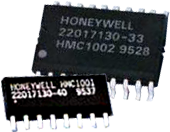
HMC100x Series Magnetic Field SensorMagnetic field sensors are commonly employed for compassing, navigation, magnetometry, proximity sensing, and current sensing applications. In general, they are classified according to low-, medium-, and high- magnetic fields.. There are several sub-types of medium field sensors, including flux gate, magnetoinductive, anisotropic magnetoresistive(AMR) and bias magnetic field sensors. AMR sensors are well suited to measuring both linear and angular position and displacement in the Earth's magnetic field. The HMC100x Series are Anisotropic Magneto-Resistive (AMR) sensors that consist of resistive Wheatstone bridges used to measure magnetic fields. With power supply applied to the bridges, the sensors convert any incident magnetic field in the sensitive axis directions to a differential voltage outputs. They are extremely sensitive sensor designed to measure direction and magnitude of Earth's magnetic fields from tens of micro-gauss to 6 gauss. Because the output is only in proportion to the one-dimensional axis, additional sensor bridges placed at orthogonal directions permit accurate measurement of arbitrary field direction. |
||||

2SS52M Series Omnipolar Digital Magnetoresistive Position SensorMagnetic position sensors ICs are commonly used to detect the extension or retraction of a pneumatic cylinder or for sensing the position of an elevator relative to a stationary reference Position Sensor ICs are categorized in four ways Bipolar Latching Unipolar and Omnipolar Bipolar sensor ICs sensors detect the magnetic field from a permanent magnet or electromagnet and respond to alternating poles(North and South Latching sensor ICs latch onto an initial pole(North or South until a magnetic field of sufficient strength of the opposite polarity is brought near the sensor IC Unipolar sensor ICs detect the magnetic field from a permanent magnet or electromagnet and respond to a single pole(North or South Omnipolar sensor ICs detect the magnetic field from a permanent magnet or electromagnet and respond to either pole(North or South The 2SS52M Series position sensors have a built-in magnetoresistive bridge integrated on silicon and encapsulated in a plastic package The integrated circuit also includes a band-gap regulator and a digital output that will respond to very low magnetic fields Other applications include gear tooth sensor proximity sensor and high-resolution magnetic encoders |
||||
| - 5.8 Force Sensors | ||||
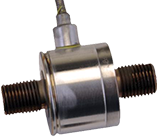
Model 31 Series Miniature Load CellA load cell is a type of sensor that generates an electrical signal whose magnitude is directly proportional to the force being measured. There are various types of load cells, including hydraulic, pneumatic and strain gauge. They are used in cable tensioning, industrial process control, aerospace testing and many more. The Model 31 Series is a low range, precision, miniature, double diaphragm load cells that can measure both tension and compression load forces of up to 500 g / 5 N. It has an accuracy of 0.15 % full scale. It has a welded, stainless steel construction that's designed to minimize or eliminate the effects of off-axis loads. |
||||
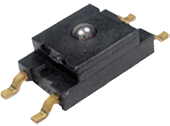
FSS-SMT Series Low-Profile Force SensorForce sensors are used in a variety of industrial applications to sense load and compression, or in variable tension control, robotic end-effectors, and wire bonding equipment. For applications that require a compact footprint, surface mount force sensors are an ideal solution. The FSS-SMT Series is a surface mount force sensor with a piezoresistive micromachined silicon sensing element. The low power, unamplified, uncompensated Wheatstone bridge circuit design provides a stable mV output over the force range. These force sensors operate on the principle that the resistance of silicon-implanted piezoresistors will change when the resistors flex under applied force. The sensor concentrates force from the applications, through the stainless-steel ball, directly to the silicon-sensing element. The amount of resistance changes in proportion to the amount of force being applied. This change in circuit resistance results in a corresponding mV output level change. The sensor package design incorporates patented modular construction. The use of innovative elastomeric technology and engineered molded plastics results in load excitation capacities up to 60 N (range dependent). |
||||
| - 5.9 Liquid Level Sensors | ||||
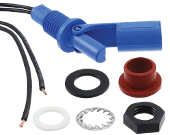
LRN Series Reed Float SwitchReed float switches provide high or low liquid level sensing for engine coolant level sensing, fuel or oil level sensing, boiler level sensing, and industrial processing for signaling and control applications. They use a magnet located in the float to activate the reed switch either on a rising or falling liquid level. When the set point is achieved, the reed float switch can operate a contact closure as normally open, normally closed or change over contact action. |
||||

LLE Series Liquid Level SensorsWhile float-type liquid level sensing switches are simple and low cost, they have some drawbacks, including that they cannot be used with highly viscous materials and debris can get stuck in the float thereby impeding operation. Optical liquid level sensors overcome some of the inherent drawbacks of elecromechanical float-type liquid level sensors. The LLE Series of optical liquid level sensors incorporate a photo-transistor trigger which provides a digital output that represents the presence or absence of a liquid. The mode of operation is derived from the principle of total internal reflection. An LED and photo-transistor are housed within a plastic dome at the head of the device. When no liquid is present, light from the LED is internally reflected from the dome to the photo-transistor. When liquid covers the dome, the effective refractive index at the dome-liquid boundary changes, allowing some light from the LED to escape. Thus, the amount of light received by the photo- transistor is reduced and the output switches, indicating the presence of liquid. This method of liquid level sensing is very fast, and almost instantaneous for water. Typical applications include appliances, compressors, machine tools and automotive applications. |
||||
| - 5.10 Object Detection Sensors | ||||
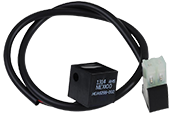
HOA6299 Series Through Beam Infrared Sensor ModulesPhotoelectric detector/emitters have been used for a long time in industrial applications. They commonly function as optical-type, object detection sensors and are frequently used as edge detectors, position sensors, and parts counting sensors in manufacturing production processes. The HOA6299 series Through Beam Infrared Sensor modules consist of an infrared emitting diode and detector, and operate as a pair. The detector's NPN output changes whenever an opaque object blocks the beam path. The buffer logic provides a logic high when the optical path is clear and a logic low when the optical path is blocked. The internal current limiting resistor in the emitter module eliminates the need for an external interface circuit. The series employs an IR transmissive housing which features smooth optical faces without external aperture openings; this feature is desirable when aperture blockage from airborne contaminants is a possibility. |
*Trademark. Honeywell is a trademark of Honeywell, Inc. Other logos, product and/or company names may be trademarks of their respective owners.
is a trademark of Honeywell, Inc. Other logos, product and/or company names may be trademarks of their respective owners.
Test Your Knowledge
Sensor Skills 3
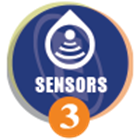
Are you ready to demonstrate your knowledge of industrial sensors? Then take a quick 15-question multiple choice quiz to see how much you've learned from this Essentials Sensors 3 module.
To earn the Sensors 3 badge, read through the module to learn all about industrial sensors, attain 100% in the quiz, and leave us some feedback in the comments section.





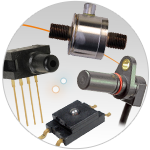
Top Comments
-

kk99
-
Cancel
-
Vote Up
0
Vote Down
-
-
Sign in to reply
-
More
-
Cancel
Comment-

kk99
-
Cancel
-
Vote Up
0
Vote Down
-
-
Sign in to reply
-
More
-
Cancel
Children